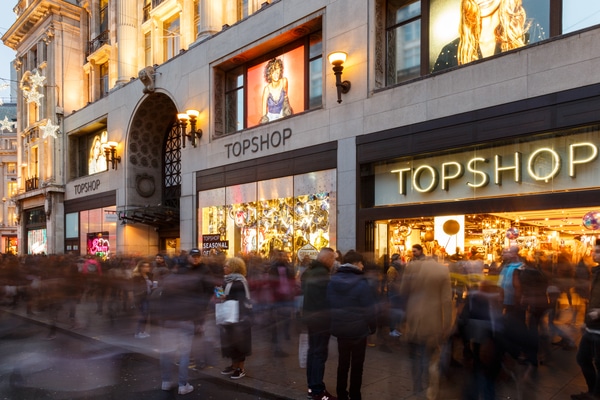A BRIEF TIMELINE
1903: 18-year-old Lithuanian immigrant Montague Burton founds The Cross-Tailoring Company in Chesterfield.
1910: The Cross-Tailoring Company’s headquarters move from Chesterfield to Leeds.
1914: By the time the First World War breaks out, The Cross-Tailoring Company has changed its name to Burton.
1929: Burton is first listed on the London Stock Exchange, by which time it has 400 stores, factories and mills and a large factory in Leeds.
1946: Burton acquires the Peter Robinson women’s fashion chain.
1952: The year Montague Burton dies, the company is the largest multiple tailor in the world.
1966: Burton is the official suit supplier of the England national football team for the World Cup in 1966.
1964: The Peter Robinson chain began a relaunch into the Topshop brand in response to the demand for new young fashion culture in Britain.
1974: The first standalone Topshop store opens, and the Peter Robinson name is eventually dropped altogether.
1985: Burton acquires Debenhams, then the largest department store group in the UK.
1991: The recession of the early 1990s takes hold, leading to a decline in sales across the clothing retail market. Burton eventually lays off 2,000 employees – almost 1,000 from its head office.
1993: Burton Group undertakes a major review of its trading space portfolio known as Townprint. At the time of the review, the group operates in the region of 1,600 stores, some of which had been with the group for some years and some of which were no longer performing adequately.
As part of the review, Burton began to roll out new ways of working, such as operating increasing numbers of combined stores, where several brands shared the same unit; these combinations (such as Topshop/Topman or Burton/Dorothy Perkins unit-shares) would continue to be developed through the 1990s and 2000s as a way of reducing overheads whilst maintaining geographical spread of the brands.
July 1997: Burton announces it will demerge Debenhams and separate it from the rest of the group.
January 1998: The demerger is approved by shareholders and takes effect later that month. Debenhams became a separate company with its own listing on the London Stock Exchange. Burton is renamed as Arcadia Group plc.
2002: Arcadia Group plc is bought by Taveta Investments, owned by Taveta Ltd based in Jersey. Taveta Ltd is owned by Philip Green’s family, the only director is Lady Tina Green, the wife of Philip Green. Arcadia Group becomes a private company and is delisted from the London Stock Exchange.
2005: Green bought the UK retail stores of Etam and Tammy, which were converted into other Arcadia retail outlets, with Tammy clothing subsequently being retailed through BHS and Outfit stores. Some of the stores not retained by Arcadia were taken up by other fashion retail groups, with Monsoon acquiring a large number of the outlets.
February 2009: Arcadia announces that the BHS department store chain, also owned by the Greens, would be integrated into Arcadia. As part of the changes, some BHS retail stores were to begin to carry Arcadia brands as concessions, enabling Arcadia to expand the presence of its brands without having to lease large numbers of new stores, allowing the firm to cut store costs by moving some operations from stand-alone stores into BHS locations.
2010: Reports circulate that Arcadia is considering a review of its property portfolio, as several hundred of the firm’s existing store leases expire over the coming three to five years. Analysts estimate that between 150 and 300 stores could be shut and replaced with new locations or integrated/combined stores. After Green confirms that the number of stores under lease was to fall in 2013-14, Arcadia begins shutting stores in a number of locations, mostly in small-to-medium-sized towns and cities. Arcadia cites the rise in online shopping and “destination” centres as a reason for moving away from high street locations.
March 2015: BHS is sold to Retail Acquisitions Ltd.
October 25, 2019: Green is named in Parliament by Lord Peter Hain as the prominent businessman accused of sexual harassment after The Telegraph was given a legal injunction to prevent his identity being revealed.
March 2019: Green is reported to be looking into a CVA to restructure the company. The plan is feared to lead to more shop closures and job losses.
April 2019: Two restructuring specialists are added to the Arcadia Group’s board to oversee the implementation of the CVA.
April 2019: Reports emerge that Arcadia group has recorded a £300m deficit into its pension fund, while the Green family had cashed out £1.2 billion in dividends from Arcadia in 2005.
May 23 2019: Arcadia Group confirms it plans to close 23 stores across the UK and Ireland with the possibility of further closures worldwide as part of a CVA. The retail group’s proposals also look to cut rents at another 194 stores, with all 11 of Arcadia’s Topman and Topshop stores in the US also set to close.
May 28 2019: Green offers to provide £185 million in additional funds from property assets to help reduce Arcadia Group’s pension deficit as part of a bid to win approval for its seven CVAs.
June 12 2019: Arcadia Group announces that its CVAs have been approved by the required majority of creditors. Lady Green will pay £50 million into the group as long as it means there will be no risk of legal challenge to the CVA.
THE REASONS
Where to begin? While the Arcadia of today is intrinsically tied to Sir Philip Green, the company founded by Montague Burton in 1903 has endured many trials in its chequered history to become one of the mainstays of British retail.
As of June 2019, the group now represents Topshop, Topman, Miss Selfridge, Burton, Evans, Dorothy Perkins and Wallis, as well as 18,000 members of staff.
On the surface, the timeline above shows a retail giant determined to survive despite change at every element of its business. But beneath that, it could be argued Arcadia’s current issues date back through the decades. What seems clear now is that Arcadia has had too many stores for more than 30 years, while its key competitors such as Asos and Boohoo have remained entirely online-only, never branching into bricks and mortar.
Especially relevant is Townprint, the major review of stores the group undertook in the early 1990s, when it was still known as Burton.
Launched in 1993 by then-Debenhams’ chief executive John Hoerner, Townprint aimed to ensure that each Burton outlet was located in the right place and properly distanced from each other. The report led to a major reorganisation of the group’s 1,600 stores, calling for the disposal of 380 units, the acquisition of 228 units, and the transfer of 354 units from one Burton Group format to another.
“It is unlikely that a restructuring via a CVA or administration will overcome what is the fundamental problem.”
While no-one in the early 1990s could have predicted the boom of e-commerce and fast fashion, many critics of Arcadia’s turnaround have been quick to point out the retailer suffers from over-exposure on the high street. Another round of CVAs may do little more than a quick fix for the business, that it also looked to address thirty years ago with Townprint.
“Arcadia have been guilty of the same crime as a number of the casual dining operators who have entered CVAs, by having too many stores in too close proximity,” said Howard Kennedy partner Nicky Stewart.
“The flaws of the financial modelling that was used to justify such numbers are sadly becoming apparent as can be seen by the number of businesses who have had to resort to CVAs. However, it is unlikely that a restructuring via a CVA or administration will overcome what is the fundamental problem.
“Sir Philip Green’s fall from grace clearly hasn’t helped either. His reputation could be affecting the current CVA negotiations as heavy weight landlords may be reluctant to grant the same concessions as they would do to other struggling retailers,” Stewart argued.
Too big to fail? It might be that one crucial issue with Arcadia is it has become too big to change.
“The rise of fresh, agile competitors has undoubtedly contributed significantly to the group’s demise.”
While its business has seen many iterations in the past one hundred years, with the rise of e-commerce, brands like Topshop and Miss Selfridge acquired new competition Arcadia’s business model is not set up to compete with easily.
“The rise of fresh, agile competitors has undoubtedly contributed significantly to the group’s demise,” said Joelson property litigation partner Daniel Swimer.
“Arcadia sells relatively little online compared to many of its rivals and it has faced a considerable threat in the last few years from online retailers such as ASOS and Boohoo,” Swimer added.
Setting aside Arcadia’s shortcomings, landlords have come under fire for increasing rents while retailers have been unable to match through sales.
With many retailers facing rising business rates and labour costs, they argue new deals with landlords are necessary for survival on the high street, and that such high leases would never be agreed upon in today’s economic climate.
On top of that, there’s the issue of dwindling market share across all of Arcadia’s brands (bar Outfit) in the past ten years that shows Green has a real fight ahead of him even now that his CVAs have been approved.
In fact, 50 store closures may be just the beginning of the turnaround for Arcadia, as experts believe it may need to cut back further in order to survive in the long-run.
“I doubt the 50 closures will be enough,” said commercial real estate advisors Harper Dennis Hobbs executive director Dan Hildyard.
“After agreeing the CVAs, the next step now is to re-engage the brand with their customer and I suspect the latter will be even more difficult than the former. The reason that I think this will be difficult, is that high street stores are constantly competing with fast-fashion retailers, who can produce low-cost products, as quickly as the consumer needs change,” Hildyard added.
“This could well be the catalyst for reinvention, rather than the ultimate road to ruin for Arcadia.”
On the other hand, landlords are concerned over the precedent a new series of CVAs sets with a major retail group such as Arcadia. Were another fast fashion giant to fall on hard times, they’d have more CVAs to contend with.
Yet with thousands of jobs at stake, it’s likely Arcadia’s landlords will feel the pressure from the general public, as well as the losses they’ll face with empty stores from failed negotiations.
“At some point, the landlords and shareholders are going to have to accept some kind of a deal. The UK retail environment is still a difficult one and, inevitably, there will be some casualties as the high street reinvents itself,“ said Retail Connections chairman Chris Field.
“Things never are as dire as the business owners like to say, and Sir Philip is no fool; and, ultimately, money comes first – this could well be the catalyst for reinvention, rather than the ultimate road to ruin for Arcadia,” Field added.
Click here to sign up to Retail Gazette‘s free daily email newsletter


















